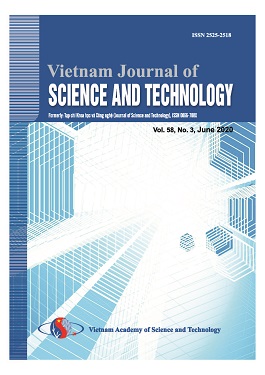Flavonoids from flowers of Amesiodendron chinense (Sapindaceae)
Author affiliations
DOI:
https://doi.org/10.15625/2525-2518/58/6/15127Keywords:
Flowers, Amesiodendron chinense, chrysoeriol, catechin, quercetin 3-O-β-D-glucoside, astragalin, and kaempferide-3-O-β-D-glucopyranoside.Abstract
From the flowers of Amensiodendron Chinese (Merr.) Hu, six known flavonoids, (-)-catechin (1), (-)-epi-catechin (2), chrysoeriol (3), quercetin-3-O-β-D-glucopyranoside (4), astragalin (5) and kaempferide-3-O-β-D-glucopyranoside (6) were isolated. Their chemical structures were elucidated by analysis of the physicochemical parameters, the NMR and mass spectral data, and comparison with those reported in the literatures.
Downloads
References
Panche A. N., Diwan A. D. and Chandra S. R. - Flavonoids: an overview, Nutritional Science 5(47) (2010) 1-15.
Nagula R. L., Wairka S. - Recent advances in topical delivery of flavonoids, Journal of controlled release 296 (2019) 190-201.
Rengasamy K. R. R., Khan H., Gowrishankar S., Lagoa R. J. L., Mahoomodally F. M., Khan Z., Suroowan S., Tewari D., Zengin G.,
Hassan S. T. S., Pandian S. K. - The role of flavonoids in autoimmune disease: therapeutic updates, Pharmacology & Therapeutics 194 (2019) 107-131.
Ban N. T., - List of Vietnamese plant species, Agriculture Publishing House, Hanoi, 2003, Vol. II, p. 1016.
Ho P. H. - An illustrated flora of Vietnam, Young Publisher, Ho Chi Minh city, 2003, Vol. II, p. 326.
Razek M. H. A. - NMR Assignments of Four Catechin Epimers, Asian Journal of Chemistry 19(6) (2007) 4867-4872.
Silva L. A. L., Faqueti L. G., Reginatto F. H., Santos A. D. C., Barison A., Biavatti M. W. - Phytochemical analysis of Vernonanthura tweedieana and a validated UPLC-PDA method for the quantification of eriodictyol, Revista Brasileira de Farmacognosia 25 (2015) 375–381.
Al-Musayeib N., Perveen S., Fatima I., Nasir M. and Hussain A. - Antioxidant, anti-glycation and anti-inflammatory activities of phenolic constituents from Cordia sinensis, Molecules 16 (2011) 10214-10226.
Seo K. H., Jung J. W., Nhan N. T., Lee Y. H., and Baek N. I. - Flavonoid glycosides from the flowers of Pulsatilla koreana Nakai, Natural Product Sciences 22(1) (2016) 41-45.
Gutzeit D., Wray V., Winterhalter P., Jerz G. - Preparative isolation and purification of flavonoids and protocatechuic acid from sea buckthorn juice concentrate (Hippophaë rhamnoides L. ssp. rhamnoides) by High-speed counter-current chromatography, Chromatographia 65 (2007) 1-7.
Jeong W. S. & Kong A. N. T. - Biological properties of monomeric and polymeric catechins: Green tea catechins and procyanidins, Pharmaceutical Biology 42 (2004) 84–93.
Isemura M., Catechin in human health and disease, Molecules 24 (2019) 528-533.
Bashyal B., Parajuli P., Pandey R. P., and Sohng J. K. - Microbial biosynthesis of antibacterial chrysoeriol in recombinant Escherichia coli and bioactivity assessment, Catalysts 9 (2019) 112-127.
Riaz A., Rasul A., Hussain G., Zahoor M. K., Jabeen F, Subhani Z., Younis T., Ali M., Sarfraz I., and Selamoglu Z., Review article, Astragalin: A bioactive phytochemical with potential therapeutic activities, Hindawi Advances in Pharmacological Sciences Volume 2018, Article ID 9794625, 15 pages, https://doi.org/10.1155/2018/9794625,
Downloads
Published
How to Cite
Issue
Section
License

This work is licensed under a Creative Commons Attribution-ShareAlike 4.0 International License.
Vietnam Journal of Sciences and Technology (VJST) is an open access and peer-reviewed journal. All academic publications could be made free to read and downloaded for everyone. In addition, articles are published under term of the Creative Commons Attribution-ShareAlike 4.0 International (CC BY-SA) Licence which permits use, distribution and reproduction in any medium, provided the original work is properly cited & ShareAlike terms followed.
Copyright on any research article published in VJST is retained by the respective author(s), without restrictions. Authors grant VAST Journals System a license to publish the article and identify itself as the original publisher. Upon author(s) by giving permission to VJST either via VJST journal portal or other channel to publish their research work in VJST agrees to all the terms and conditions of https://creativecommons.org/licenses/by-sa/4.0/ License and terms & condition set by VJST.
Authors have the responsibility of to secure all necessary copyright permissions for the use of 3rd-party materials in their manuscript.







 Vietnam Journal of Science and Technology (VJST) is pleased to notice:
Vietnam Journal of Science and Technology (VJST) is pleased to notice: